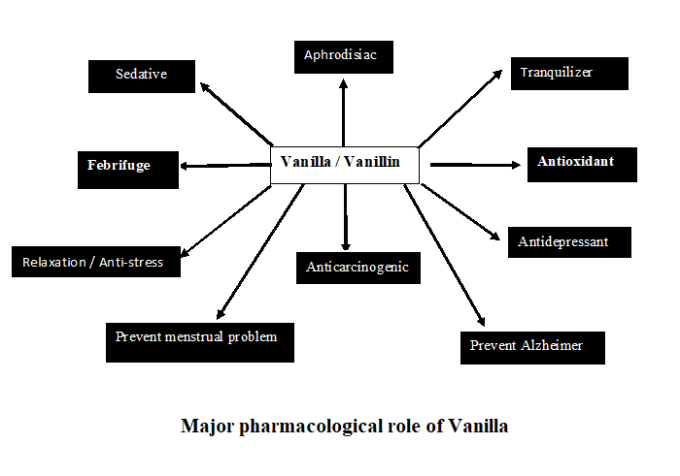Vanilla
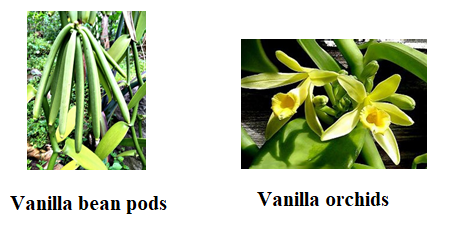
General features: It is pleasant smelling orchid belonging to the Orchidaceae family of Vanilla genus. The plant is a tropical flowering vine (50 – 75 ft height) that grows small bean pods 6 – 8 inches in length and 1/3 inch wide. The word Vanilla originates from the Spanish word ‘Vaina’ signifying pod. It is seemingly the second after Saffron according to price among the spices. The genus produces 110 species belonging to the orchid family. The commonly used one is flat leaved termed as Vanilla planifolia, a native of Mexico. Its use in South American countries date back to the Aztec civilization. Herman Cortes, the famous Spanish conqueror introduced this pleasant-smelling spice along with the other precious one, chocolate to the European society around 1520. The bean pods which are ~ 6 inches long are the number one category whereas those over that limit, fall into the second-grade. The developed vine produces ~ 100 pods in a year maturing around 8 – 9 months after flowering. Interestingly, if too many flowers undergo pollination at a time producing excessive number of pods that might bring death to the vine. The green beans are normally harvested at the onset of sunrise then wrapped inside the warm woolen blankets keeping for fermentation under the warm midday sun. Later they are preserved inside a metal lined air tight box. This is called ‘sweating or curing process’ that lasts for few weeks. In that way, vanillin is produced after undergoing degradation by the enzyme, Glucosidase which removes the glucose moiety while producing respective products.

A matured vine of five years old produces 3.5 lbs beans that increases to the extent of maximum ~ 7lb in next two years. Only three major species of Vanilla are used all over the world. The one of major use is Vanilla planifolia, the Mexican variety that grows better in Madagascar and Indonesia. The others are Vanilla tahitensis and Vanilla pompona which also grow in tropical climate in the Islands of Indian ocean, West Indies and Central and Southern American countries. Madagascar produces more than two thirds (2.9 K tonnes) of the entire world supply and the quality is supreme. Indonesia picks the next (2.3 K tonnes) and later comes Mexico (0.6 K Tonnes) and Papua New Guinea (0.5 K tonnes). The major aroma producing components are synthesized inside the fruits. Each flower produces just one pod. The interior of pod consists of large number of tiny seeds (0. 3 – 0.5 mm in diameter) marinated in oil. They undergo self-pollination since they carry both male (anther) and female (stigma) organs. But self-pollination is prevented inside the flower by a naturally separating membrane dividing the organs. The pollination is only carried out by the mountain bees, Eulaema or hummingbirds. This event once provided Mexico a special advantage that lasts almost 300 years until hand pollination came into the practice, invented by Charles Morren in 1836, a Mexican botanist. The process is now followed everywhere even in Mexico which has been improved significantly. Numerous attempts to grow this orchid to grow vanilla commercially in European climate are failed. The plant severely needs tropical climate to grow. The main flavoring agent is Vanillin (m – methoxy- p – hydroxy benzaldehyde) which is produced synthetically in recent days for numerous culinary and cosmetic needs.
History and mythology: History reveals that Totonac, the early inhabitants of east coast of Mexico, present day Veracruz first started the cultivation of Vanilla. Totonac mythology tells that Princess Xanat married a mortal disobeying her father’s objection and alongside fled in the forest with lover. Following the capture, both were executed. The myth says, when their blood touched the soil, there grows this sweet-smelling vine, Vanilla. The legend indicates that this sweet and pleasant smell is a sign of immortal love. In 15th century, Aztecs conquered that place and initiated its cultivation since by that time they also developed the taste as well. Then the Totonac people were used as slaves for its cultivation. Until the 19th century, Mexico was the largest producer. At the beginning of 19th century a bunch of French entrepreneurs shipped Vanilla fruits and started its cultivation in the islands of Mauritius and Reunion. Since the technique of hand pollination was already in progress so this orchid traveled to the other tropical islands for cultivation like Seychelles, Madagascar, Indonesia and Comoros islands. In time, Madagascar becomes the highest producer and Indonesia stands to be the next.
Uses: For culinary purposes, Vanilla is normally employed for baking or making ice creams, puddings, chocolates, liquors and soft drinks. Its other use is found in the field of cosmetics. But it finds some medicinal uses also. In traditional or folk medicine, Vanilla is applied to treat the fever or hysteria. It stimulates brain increasing energy and promoting the sexual drive thus acting as an aphrodisiac. In the past around 16th or 17th century, European apothecaries used Vanilla oil as an antidote for poisoning, stomach complaints and aphrodisiac. In old days in many places of Africa people used Vanilla for the same purposes. It shows antispasmodic and calming sensation. It is also used as emmenagogue, antioxidant and anti-depressant. Additionally, Vanilla oil has further beneficial roles. It regulates menstruation, relieve nausea, lowers anxiety, stress, insomnia, healing wounds, induces sleep, encourages dreaming and enhances libido. As per other uses, the sweet warm smell of Vanilla oil is often exploited as a perfume. It offers intense sense of relaxation for deep sweet scent enabling to penetrate the nervous system. It is used in aromatic candle or mixed with the humectants to use in moisturizing cream.
Chemical components: The major composition of vanilla fruits is: water ~ 30 %, various mineral salts ~ 3.0 – 5.0 %, Carbohydrates ~ 20 %, Lipids ~ 8 – 10 %, Vanillin ~ 1.5 – 3.8 %. Besides Vanillin, the herb produces reducing monosaccharides, sucrose and oil. The chemical ingredients of oil are Vanillin (~ 85 %), Eugenol, Piperonal and Caproic acid. Among those, Vanillin is the actual flavoring agent in the Vanilla bean. In addition to that, the other flavoring agents are p – hydroxy benzaldehyde and p – hydroxy benzyl methyl ether. The other chemical components are Furfural, Hexanoic acid, Methyl Cinnamate and Iso-butyric acid. In 1858, Vanillin was isolated from the Vanilla beans by the French chemist, Gobley. Afterward it has been successfully synthesized in the laboratory. In recent days, majority of it is a synthetic product.
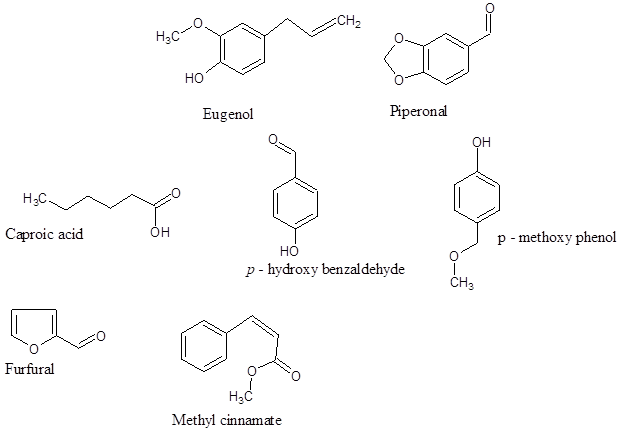
Medicinal effects: The medicinal actions of Vanilla components mostly rely on anti-oxidant property that efficiently prevents any DNA damage due to ROS and NOS productions caused by the infections or other diseases furthering many catastrophic ailments that includes cancers or tumors. Studies already indicated that Vanillin has potential anti-carcinogenic action. It kills cancer cells also prevents them to be metastasized. Concerning the cardiovascular role, Vanillin reduces cholesterol level. It lowers the risks of blood clotting and along side behave as an anti-inflammatory component. The combined effects help reduce the chance of atherosclerosis. Because of the anti-oxidant role, it stimulates normal growth preventing the breaking down of cells or tissues. As per further actions, owing to anti-bacterial nature it protects the immune system, lowers stress and helps recover the body from any injury or ailments. The components of Vanilla also behave to be an antiphlogistic, effective enough to reduce fever and inflammation. In that regard, Eugenol and Vanillin are noticed to be the potent components because of the anti-infection property. The use of Vanilla both in food or cosmetics stimulates secretion of sex hormones like testosterone and estrogen that promotes the arousal reviving sexual performance. From the very ancient times, Vanilla is considered as an aphrodisiac. The oil of this herb helps recuperate dysfunctionality, impotency, frigidity or loss of libido helping sufferers getting out of the problems. The major component Vanillin is also a strong anti-depressant whether consumed orally or as olfactory odorant. It puts everyone in good mood irrespective of the ages, from toddlers to adults. Vanilla also induces sedative effects. Vanilla oil generates calming and relaxing sensation on nervous system relieving anxiety, anger, restlessness and mental stress, helping lower the blood pressure. It also provides good night sleep for its tranquilizing role. It recently indicates that Vanillin has a potent role to prevent or resist the progression of neurological diseases like Alzheimer’s dementia and even Parkinson’s disorder.
Pharmacological role of Vanillin on Alzheimer inhibiting amyloid aggregate formation: The intriguing observation in recent days shows that Vanillin or any phenolics with similar structural moiety enables prevent amyloid aggregate formation during non-enzymatic glycation restraining the production of advanced glycation end products (AGE). Amyloid aggregation or AGE production is the result of protein glycation. The event is associated to the mechanisms behind several diseases like, retinopathy, neuropathy, nephropathy, macro-vascular diseases, Alzheimer, cataract and aging. The amyloid formation is a tendency noticed among the most proteins. In that act, blood proteins or peptide hormones like insulin is no exception. It is observed that insulin also undergoes amyloid fibril formation at the site of injection, known as injection amyloidosis. The incidence creates a hard-subcutaneous mass which often triggers the immune responses causing impairment in insulin absorption. Vanillin strongly resist that process of amyloid formation of human insulin. As an added factor, glycation by glucose is very much associated with the development of diabetic complications. Under physiologic condition glucose undergoes degradation to glyoxal or methyl glyoxal, which is a key factor in the path to form glycated protein production bringing conformational changes to secondary structures eventually facilitating the plaque formation. The amyloid fibrils consists of β – sheet structure that runs perpendicular to the fibril’s axis. They are formed by stepwise events eg, oligomerization, nucleation and growth phase. Among the steps, nucleation event is the slow one whereas growth phase turns to be the fast. It has been observed that the level of methyl glyoxal (CH3COCHO) production is increased within cultured red blood cells along with the increment of glucose in the media. The incident turns identical to the enhanced production of methyl glyoxal observed in blood, kidney and lenses during hyperglycemia which has been verified even in the case of experimentally induced diabetic animals. Experiments further indicate that methyl glyoxal undergoes reduction by Vanillin inhibiting the generation of fibrils or AGE. It is hypothesized that Vanillin traps methyl glyoxal directly. Below are the chemical steps identified for AGE formation.
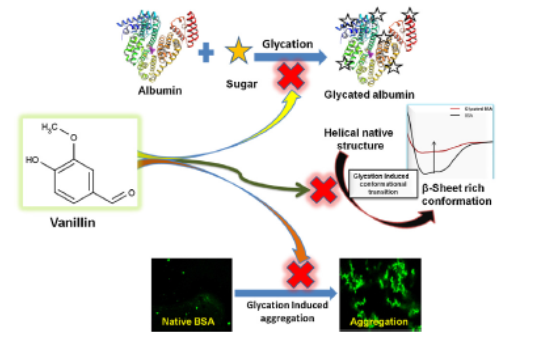
Natural production of glyoxal or methyl glyoxal – The production of reactive di-carbonyl is the important factor in overall process.
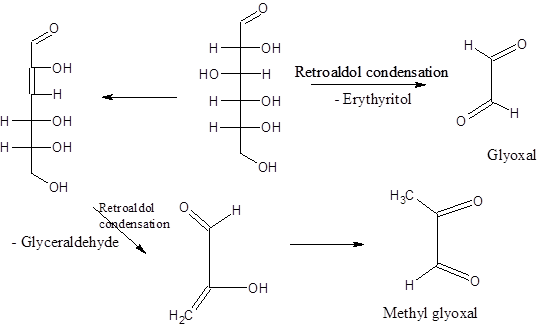
Production of methyl glyoxal from the Amadori products –
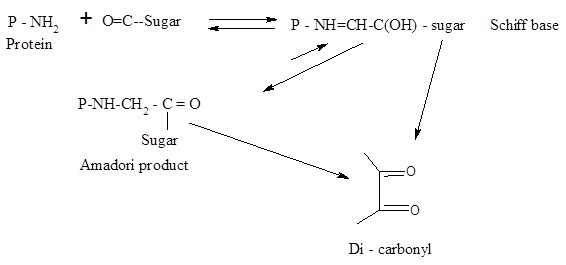
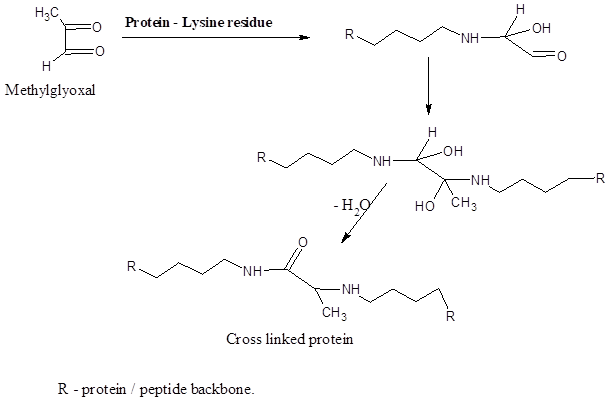
Pharmacology of Vanillin receptor – The sweet and pleasant smell of Vanilla originates from the chief ingredient, Vanillin. The compound activates Transient receptor potential channel – V1 and – V3 (TRPV1 & TRPV3). But the major interaction is with TRPV1 which is formerly known as Vanilloid receptor – 1 (VR1). It is a nonselective cation channel with high Ca+2 permeability. It is expressed in the population of sensory neurons. The primary sensory afferent neurons on trigeminal ganglia transmit sensory information bringing awareness about chemical surroundings to the brain. Numerous components act as stimuli including the olfactory odorants which interact with sensory neurons of the trigeminal ganglia. That sensory elements belonging to the trigeminal area are liable for the perception of smell causing changes in membrane potential. In course of interaction with Vanillin, the dose-dependent depolarization has been observed. Using specific antagonists, it is identified that Vanillin largely stimulates TRPV1and in that course, it subsequently inhibits the K+ channels, TASK1 and TASK3. This is perhaps the underlying mechanism behind smell perception of Vanillin via the trigeminal ganglion neurons.
